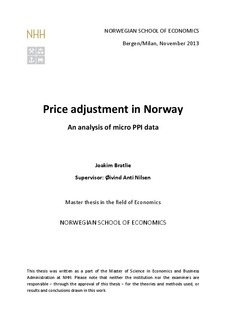Price adjustment in Norway : an analysis of micro PPI data
Master thesis
Permanent lenke
http://hdl.handle.net/11250/195662Utgivelsesdato
2013Metadata
Vis full innførselSamlinger
- Master Thesis [4372]
Sammendrag
We have only limited knowledge about how Norwegian producers change their prices. The aim of this thesis has therefore been to gain greater insight in the price adjustment on producer level in Norway. Throughout the paper I have gathered evidence on the adjustment patterns of Norwegian producers within manufacturing, mining and quarrying. Light has been shed on the field through the presentation of a wide range of descriptive statistics, focusing on the producers’ price change frequency, price adjustment size, and duration of price spells, in order to assess whether there are signs of price rigidities. Through the paper the analysis has also been conducted at disaggregated levels, and variations in pricing behavior between different sectors and product groups are therefore presented. These descriptive findings have been compared to empirical evidence from other European countries. They have further been used to assess the validity of the underlying assumptions of a number of so-called dynamic stochastic general equilibrium (DSGE) pricing models. The adjustment of Norwegian producer prices appear to be more or less coherent with the adjustment observed in Europe, though some differences are observable. Furthermore, there are indeed signs of rigidities on the producer level in Norway. The producers’ prices seem to last longer, have a lower change frequency and larger changes in absolute value than most models of today are able to account for. Additionally, there are clear heterogeneities between different sectors and product categories, as well as seasonal differences, and these factors are causing rigidities that must also be taken into account in the macro model design process. In general, the findings show that most of the presented DSGE models’ underlying assumptions fail to match the empirical evidence. This is measured by their ability to allow for infrequent adjustment, heterogeneity between producers, and decreasing, non-zero hazard rates with annual spikes; important micro evidence presented not only in this thesis, but a growing empirical literature. Some of the pricing models come closer to matching the empirical findings, and are thereby to a larger extent than others able to incorporate the real adjustment patterns and rigidities. However, there is still an open question what is the most ideal design of such a model.
